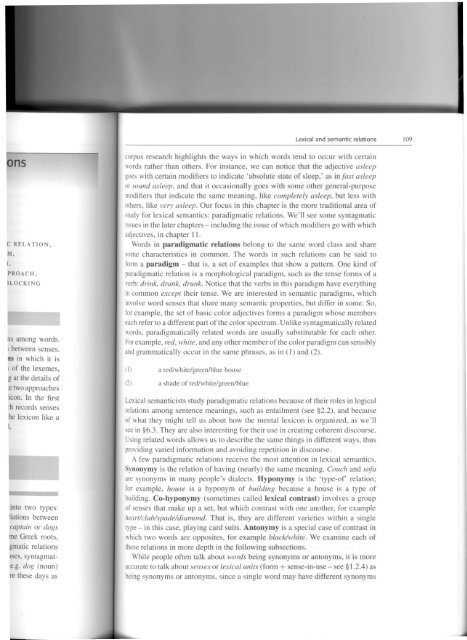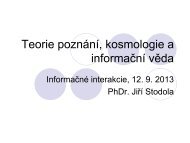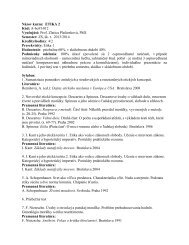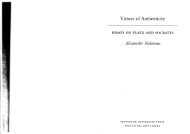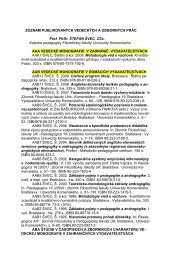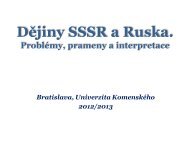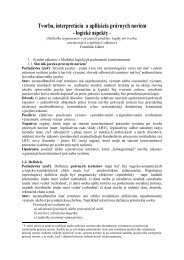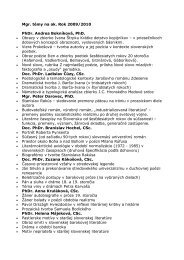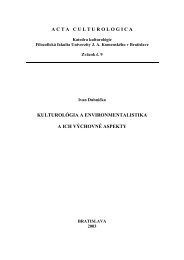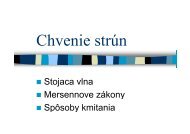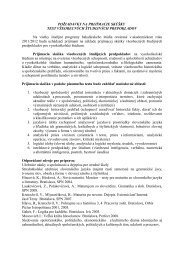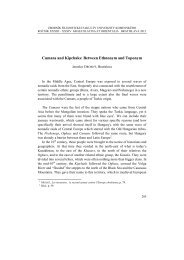You also want an ePaper? Increase the reach of your titles
YUMPU automatically turns print PDFs into web optimized ePapers that Google loves.
ans<br />
C RELATION,<br />
M,<br />
l,<br />
PROACH ,<br />
ILOCKJNG<br />
n among words.<br />
i between en es.<br />
n in which it i<br />
i of the lexemes,<br />
g at the detai I of<br />
:etwo approache<br />
icon. In the fir t<br />
:h records sense<br />
he lexicon like a<br />
l.<br />
into two type :<br />
ilations between<br />
captain or dogs<br />
me Greek roots,<br />
gmatic <strong>relations</strong><br />
ses, syntagmate.g.<br />
dog (noun)<br />
re these day as<br />
Lexical <strong>and</strong> <strong>semantie</strong> <strong>relations</strong> 109<br />
corpu re earch highlight the way in which word tend to occur with certain<br />
words rather than other. For in tance, we can notice that the adjective asleep<br />
goe with certain modifier to indicate 'ab olute tate of sleep,' as in fast asleep<br />
or sound asleep, <strong>and</strong> that it occasionally goe with orne other general-purpose<br />
modifier that indicate the arne meaning, like completelyasleep, but le with<br />
others, like very asleep. Our focus in thi chapter i the more traditional area of<br />
tudy for <strong>lexical</strong> emantic : paradigmatic relation. We'll see orne yntagmatic<br />
is ue in the later chapter - including the issue of which modi fiers go with which<br />
adjectives, in chapter Il.<br />
Words in paradigmatíc <strong>relations</strong> belong to the ame word cla s <strong>and</strong> hare<br />
orne characteri tie in common. The word in uch <strong>relations</strong> can be aid to<br />
form a paradigm - that i , a et of example that how a pattern. One kind of<br />
paradigmatic relation i amorphological paradigrn, uch as the tense forms of a<br />
verb: drink, drank; drunk. Notice that the ve rb in this paradigm have eve ry thing<br />
in common except their ten e. We are interested in emantic paradigms, which<br />
involve word sen e that hare many emantic propertie , but differ in orne. So,<br />
for example, the et of ba ic color adjective form a paradigm who e members<br />
each refer to a different part of the color spectrurn. Unlike syntagmatically related<br />
words, paradigmatically related word are u ually ub titutable for each other.<br />
For exarnple, red, white, <strong>and</strong> any other member of the color paradigm can en ibly<br />
<strong>and</strong> grammatically occur in the ame phrases, as in (l) <strong>and</strong> (2).<br />
(l) a red/white/green/blue house<br />
(2) a hade of red/white/green/blue<br />
Lexical emantici t tudy paradigmatic relation becau e of their roles in logical<br />
relation arno ng entence meanings, uch a entailment (see §2.2), <strong>and</strong> because<br />
of what they might tell us about how the mental lexicon is organized, as we'lI<br />
ee in §6.3. They are alointeresting for their u e in creating coherent discourse.<br />
U ing related word allow u to describe the ame things in different way, thu<br />
providing varied information <strong>and</strong> avoiding repetition in di cour e.<br />
A few paradigmatic <strong>relations</strong> receive the mo t attention in <strong>lexical</strong> emantics.<br />
Synonymy i the relation of having (nearly) the ame meaning. Couch <strong>and</strong> sofa<br />
are ynonym in many people' dialect. Hyponymy i the 'type-of' relation;<br />
for example, house i a hyponym of building becau e a house i a type of<br />
building. Co-hyponymy (ometime called <strong>lexical</strong> contrast) involves a group<br />
of ense that make up a et, but which contra t with one another, for example<br />
heart/club/spade/diamond. That i , they are different varietie within a single<br />
type - in thi ca e, playing card uit. Antonymy i a peci al ca e of contra t in<br />
which two word are oppo ite, for example black/white. We examine each of<br />
these relation in more depth in the following sub ection .<br />
While people of ten talk about word being ynonyms or antonyrn , it i more<br />
accurate to talk about senses or <strong>lexical</strong> units (form + en e-in-u e - see § 1.2.4) as<br />
being ynonym or antonym, ince a ingle word may have different ynonym


